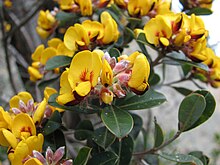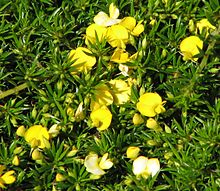Pultenaea
| Pultenaea | |
|---|---|

| |
| Pultenaea daphnoides in Kooyoora State Park | |
| Scientific classification | |
| Kingdom: | Plantae |
| Clade: | Tracheophytes |
| Clade: | Angiosperms |
| Clade: | Eudicots |
| Clade: | Rosids |
| Order: | Fabales |
| Family: | Fabaceae |
| Subfamily: | Faboideae |
| Clade: | Mirbelioids |
| Genus: | Pultenaea Sm.[1]
|
| Type species | |
| Pultenaea stipularis | |
| Species | |

| |
| Range of Pultenaea Sm. | |
| Synonyms[1] | |
| |

Pultenaea is a genus of about 100 species of flowering plants in the family
Description
Plants in the genus Pultenaea are erect to low-lying or prostrate shrubs with simple leaves usually arranged alternately, usually with papery
Taxonomy
The genus Pultenaea was first formally described by botanist James Edward Smith in 1794 in A Specimen of the Botany of New Holland.[6] The first species he described was P. stipularis from a living specimen raised in Stockwell, England from seed obtained from New South Wales in 1792.[7] Smith named the genus in honour of Richard Pulteney, an English surgeon and botanist, who also was the biographer of Linnaeus.[8]
Species list
Phylogeny
Pultenaea belongs to the Mirbelioid clade of the legume subfamily Faboideae. Pultenaea is paraphyletic with respect to several of the other mirbelioid genera.[9][10]
The genus is not considered to be
Speciation
The
Distribution
Species of Pultenaea occur in all Australian states and the Australian Capital Territory but not the Northern Territory.[1]


Use in horticulture
A number of species are cultivated for their spring flower display. Most of these are fast-growing and adaptable to diverse growing conditions. Propagation is from semi-mature cuttings or seed pre-treated by soaking in hot water.[14]
Three cultivars are registered with the Australian Cultivar Registration Authority:
- Pultenaea pedunculata 'Pyalong Gold'
- Pultenaea pedunculata 'Pyalong Pink'
- Pultenaea villosa 'Wallum Gold'—a prostrate form[15]
References
- ^ a b c "Pultenaea". Australian Plant Census. Retrieved 17 June 2021.
- ^ "Genus Pultenaea". Royal Botanic Garden Sydney. Retrieved 17 June 2021.
- Department of Biodiversity, Conservation and Attractions.
- ^ "Pultenaea". State Herbarium of South Australia. Retrieved 17 June 2021.
- ^ Corrick, Margaret G. "Pultenaea". Royal Botanic Gardens Victoria. Retrieved 17 June 2021.
- ^ "Pultenaea". Australian Plant Name Index. Retrieved 17 June 2021.
- ^ Smith, James E. (1794). A Specimen of the Botany of New Holland. London. pp. 35–38. Retrieved 17 June 2021.
- ^ Crisp M. (2 May 2009). "Fabaceae tribe Mirbelieae: Pultenaea". The Australian National University. Archived from the original on 14 October 2009. Retrieved 15 October 2009.
- ISBN 9781842460542.
- S2CID 84466412.)
{{cite journal}}: CS1 maint: multiple names: authors list (link - doi:10.1071/SB04016.)
{{cite journal}}: CS1 maint: multiple names: authors list (link - ^ doi:10.1071/SB04028.)
{{cite journal}}: CS1 maint: multiple names: authors list (link - doi:10.1071/SB02028.
- ISBN 978-0207154607.
- ^ "List of Registered Cultivars derived from Australian native flora". Australian Cultivar Registration Authority. Retrieved 2009-10-14.
![]() Media related to Pultenaea at Wikimedia Commons
Media related to Pultenaea at Wikimedia Commons
